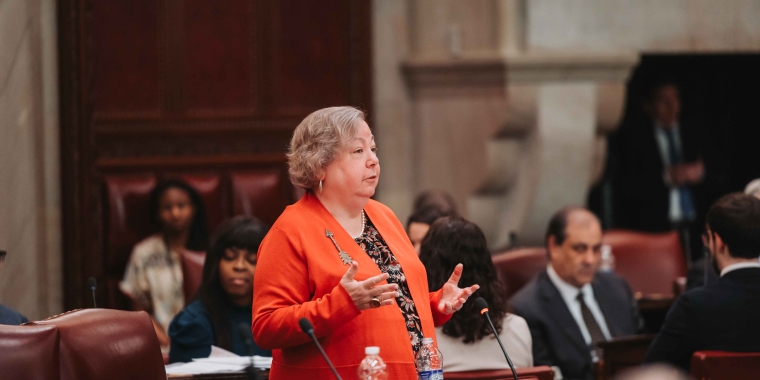
Senator Krueger's Testimony Before the LATFOR Hearing on Redistricting
Liz Krueger
September 21, 2011
TESTIMONY OF STATE SENATOR LIZ KRUEGER
BEFORE THE LEGISLATIVE TASK FORCE ON
DEMOGRAPHIC RESEARCH AND REAPPORTIONMENT (LATFOR)
REGARDING CONGRESSIONAL AND LEGISLATIVE REDISTRICTING
September 21, 2011
Good morning. I am Liz Krueger, the State Senator for the 26th District, which includes the Upper East Side, East Midtown and Midtown in Manhattan. I am here to testify on the importance of a transparent and open process for establishing new legislative districts, and for the creation of districts that meet basic standards of equity and that ensure representation to the diverse communities that make up our state.
Unfortunately, the failure of the legislature to establish an independent redistricting commission, as I and many of my colleagues have called for, will make it much more difficult for the kind of process and results we need. Given both past performance and the clear control of LATFOR by legislative leadership, I am extremely skeptical that this body is prepared to act to establish fair district lines. Shortly after I was elected to the Senate in a Special Election in February 2002, I saw LATFOR offer a plan that served entrenched political interests by disenfranchising minority communities, creating districts with substantially different numbers of voters, drawing bizarrely shaped districts made up of disparate and unrelated neighborhoods, and adding a new “surprise” 62nd Senate district at the very last minute.
Should this past history be repeated in the development of this years’ plan, I have confidence that Governor Cuomo will keep his promise and veto the plan, and I will strenuously urge him to do so. I therefore urge you to break with past practice, and take the steps necessary to develop a redistricting plan that passes muster as not serving the narrow interests of majority party leaders and incumbents, but instead serves to maximize the power of the people to choose their own representatives.
One issue of great concern to me is recent reports that LATFOR is considering expanding the size of the Senate by one or more additional seats. This action would repeat past history, replicating the last minute backroom deal that expanded the Senate from 61 to 62 seats in 2002. It would also be a slap in the face of the voters of New York State to expand the Senate at a time when so many other vital programs, from healthcare to education to social services, are facing cuts. While voters often disagree about what to cut and what to fund, I am quite sure that the vast majority would be outraged if their Senators were to tell them that what they really need from government is more State Senators. I know voters in my district would find such a claim outrageous, and I am sure the reaction in more conservative districts would be even stronger. Any expansion of the Senate would also be an attack on Governor Cuomo’s efforts to create a leaner, more efficient government, and therefore I fully expect he would veto such a plan.
So what should be the principles on which district lines should be drawn? By now the standards for independent redistricting are well established. I urge LATFOR to adopt a plan that:
• Keeps communities of interest together. To the greatest extent possible, districts should be drawn that will allow communities of interest, whether these be racial, ethnic or neighborhood based, to elect representatives of their own choosing. LATFOR’s history on this issue is unfortunately not encouraging, particularly on Long Island, where in 2002 Senate districts were drawn that split minority communities between multiple districts, diluting the voting power of African American and Latino voters. Should this pattern be repeated, the Governor must veto the redistricting plan.
• Creates districts that have the same number of voters. In 2002 LATFOR pushed the limits of district variation, creating much smaller Senate districts upstate than downstate, with a variation as great as ten percent, meaning that some New York City districts had over 27,000 more people than some upstate districts. I have had to explain to voters in NYC that they get less representation than upstate voters because the NYC Senate districts were intentionally over-populated in 2002 to allow additional upstate under-populated districts. I urge LATFOR to create districts with a overall population variation of no more than two percent, as Governor Cuomo has called for. Such a standard would require that districts would not go over +1% or under -1% of the average district population based on the 2010 census. Since Congressional Districts are already required to be equal in size, there is no legitimate argument that State legislative districts should be permitted the large population variations we have seen in the past, unless required to meet requirements of the State Constitution or the federal Voting Rights Act.
• Creates contiguous districts. Districts should not be drawn, as they have been in the past that pull together distant and unrelated communities for partisan reasons. This strategy has been used to build bizarrely shaped districts such as the 34th Senate District in the Bronx and Westchester (the lobster claw), or the 51st Senate District in Central New York (Lincoln riding a lawnmower) for the sole purpose of protecting incumbents. Legislators should not get to choose their voters – voters should get to choose their Legislators.
• Count prisoners in the districts where they come from. This standard is now the law of the State, and LATFOR should not in any way delay or undermine the implementation of this law. Prisoners do not vote from prison, but they will be voters in the neighborhoods to which they return, and they are part of the community of interest of their permanent home. The new law requires LATFOR to develop a redistricting database in which prisoners in federal and state custody have been subtracted from their place of incarceration, and in which prisoners in state custody are, to the extent possible, reallocated to their prior residential addresses LATFOR should also provide opportunity for public comment and review of the allocation of prisoners to ensure that districts conform to the new law.
The development of this redistricting plan must be open to public participation, and that means more than just holding hearings. The comments I and others are making should be addressed by LATFOR publicly as well. Given past performance, the public will be justifiably suspicious of the results of the redistricting process, and unless the reasoning behind the final product is clear, and that reasoning conforms to the principles outlined by myself and other testifiers, the final plan will not be viewed by the people of New York State as legitimate. Instead, it will confirm voters’ suspicions that this plan was developed for cynical purposes, to protect incumbents and preserve control of the Senate in its current hands.
I firmly believe that as elected officials, none of us should be afraid to face the voters in fairly drawn districts. Then we can be judged on the merits of our records. In fact I would relish it, since the last redistricting plan in 2002 removed some neighborhoods from my district where I had performed particularly well.
I hope that LATFOR will develop a plan that demonstrates that those elected officials who control this process are also not afraid of the voters, and are willing to compete in districts designed to provide the best representation for New Yorkers. If LATFOR fails to deliver a redistricting plan that meets that standard, I will be calling on Governor Cuomo to keep his promise to veto any plan that is not truly independent. This would throw the final result into the courts, which is hardly an ideal outcome, but is certainly better than continuing to allow legislators to draw their own districts, create more legislative offices, and undermine the voting power of New Yorkers. Thank you for the opportunity to testify.



